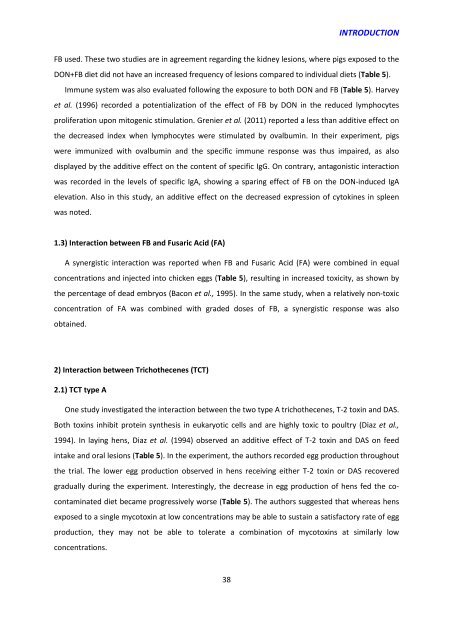Effet chez le porcelet d'une exposition à un régime co-contaminé en ...
Effet chez le porcelet d'une exposition à un régime co-contaminé en ...
Effet chez le porcelet d'une exposition à un régime co-contaminé en ...
You also want an ePaper? Increase the reach of your titles
YUMPU automatically turns print PDFs into web optimized ePapers that Google loves.
INTRODUCTIONFB used. These two studies are in agreem<strong>en</strong>t regarding the kidney <strong>le</strong>sions, where pigs exposed to theDON+FB diet did not have an increased frequ<strong>en</strong>cy of <strong>le</strong>sions <strong>co</strong>mpared to individual diets (Tab<strong>le</strong> 5).Imm<strong>un</strong>e system was also evaluated following the exposure to both DON and FB (Tab<strong>le</strong> 5). Harveyet al. (1996) re<strong>co</strong>rded a pot<strong>en</strong>tialization of the effect of FB by DON in the reduced lymphocytesproliferation upon mitog<strong>en</strong>ic stimulation. Gr<strong>en</strong>ier et al. (2011) reported a <strong>le</strong>ss than additive effect onthe decreased index wh<strong>en</strong> lymphocytes were stimulated by ovalbumin. In their experim<strong>en</strong>t, pigswere imm<strong>un</strong>ized with ovalbumin and the specific imm<strong>un</strong>e response was thus impaired, as alsodisplayed by the additive effect on the <strong>co</strong>nt<strong>en</strong>t of specific IgG. On <strong>co</strong>ntrary, antagonistic interactionwas re<strong>co</strong>rded in the <strong>le</strong>vels of specific IgA, showing a sparing effect of FB on the DON-induced IgAe<strong>le</strong>vation. Also in this study, an additive effect on the decreased expression of cytokines in sp<strong>le</strong><strong>en</strong>was noted.1.3) Interaction betwe<strong>en</strong> FB and Fusaric Acid (FA)A synergistic interaction was reported wh<strong>en</strong> FB and Fusaric Acid (FA) were <strong>co</strong>mbined in equal<strong>co</strong>nc<strong>en</strong>trations and injected into chick<strong>en</strong> eggs (Tab<strong>le</strong> 5), resulting in increased toxicity, as shown bythe perc<strong>en</strong>tage of dead embryos (Ba<strong>co</strong>n et al., 1995). In the same study, wh<strong>en</strong> a relatively non-toxic<strong>co</strong>nc<strong>en</strong>tration of FA was <strong>co</strong>mbined with graded doses of FB, a synergistic response was alsoobtained.2) Interaction betwe<strong>en</strong> Trichothec<strong>en</strong>es (TCT)2.1) TCT type AOne study investigated the interaction betwe<strong>en</strong> the two type A trichothec<strong>en</strong>es, T-2 toxin and DAS.Both toxins inhibit protein synthesis in eukaryotic cells and are highly toxic to poultry (Diaz et al.,1994). In laying h<strong>en</strong>s, Diaz et al. (1994) observed an additive effect of T-2 toxin and DAS on feedintake and oral <strong>le</strong>sions (Tab<strong>le</strong> 5). In the experim<strong>en</strong>t, the authors re<strong>co</strong>rded egg production throughoutthe trial. The lower egg production observed in h<strong>en</strong>s receiving either T-2 toxin or DAS re<strong>co</strong>veredgradually during the experim<strong>en</strong>t. Interestingly, the decrease in egg production of h<strong>en</strong>s fed the <strong>co</strong><strong>co</strong>ntaminateddiet became progressively worse (Tab<strong>le</strong> 5). The authors suggested that whereas h<strong>en</strong>sexposed to a sing<strong>le</strong> my<strong>co</strong>toxin at low <strong>co</strong>nc<strong>en</strong>trations may be ab<strong>le</strong> to sustain a satisfactory rate of eggproduction, they may not be ab<strong>le</strong> to to<strong>le</strong>rate a <strong>co</strong>mbination of my<strong>co</strong>toxins at similarly low<strong>co</strong>nc<strong>en</strong>trations.38

















